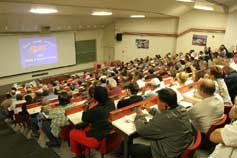

Thursday - September 7, 2006
SLAC Today is
available online at:
http://today.slac.stanford.edu
In this issue:
Labwide Safety Briefings Today
SLAC's LARP Phase II Collimator Program
SLUO Annual Meeting Takes Place on Monday
 |
 |
|
Thursday - September 7, 2006 |
Labwide Safety and Security Briefings Today
The 2005 Safety and Security Briefing The SLAC Annual Safety and Security Briefings take place today in the Panofsky Auditorium. Speakers at the briefing will discuss the importance of integrating safety and security into all aspects of work at SLAC. "The information delivered at these presentations will be fresh and useful," said Jonathan Dorfan. "Although we are all busy, I ask everyone at SLAC to attend one of today's four briefings; it will be worth your time." In addition to the main presentations, information about SLAC's Safety and Security Integrated Management program will also be available at "expo" tables set up in the Auditorium Lobby and Breezeway. Subject matter experts will be on hand to answer questions about topics including counter-intelligence, site security, property management and protection, fire protection, computer security, safety, and emergency preparedness. Suggested attendance times are broken down alphabetically to ensure adequate space in the auditorium at all sessions. If you have questions about this event, contact Doug Kreitz. |
||
|
|
||
 SLAC's LARP Phase II Collimator Program
When Jim Strait of Fermilab gave a seminar at SLAC in 2003 about technical challenges at the Large Hadron Collider (LHC) as part of the SLAC Scenarios series, he highlighted the issue of LHC collimation. Collimators are blocks of material that form small openings through which a beam must pass. They scrape away beam tails, delivering only the clean core of the beam to experiments, and, as the tightest hole in the transport line, protect more easily damaged devices. In the LHC collimation system, the 7 TeV 350 MegaJoule proton beam—energetic enough to melt 1,000 pounds of copper—will pass through a series of adjustable ~3 millimeter wide gaps formed by the edges, or jaws, of ~1 meter long blocks. In normal operation the jaws must stay aligned to the level of 25 microns, the diameter of a human hair, while efficiently removing 90 kW of errant protons, twice the beam power of the SLAC Linear Collider (SLC). As if that wasn't enough, Jim's challenge was to come up with a scheme to deal with the rare, but eventual, problem of the accidental pre-firing of the fully-energized beam abort kicker magnet system, which would slam a MegaJoule of protons into a jaw in 200 nanoseconds. The accompanying picture shows what about half a MegaJoule of 16 GeV electrons can do to a 1 meter long block of copper, a typical material for collimator jaws. Read more... |
SLUO Annual Meeting Takes Place on MondayThe SLAC Users Organization (SLUO) annual meeting is only four days away! This year, the event will take place on Monday, September 11 in Panofsky Auditorium. "We hope this meeting will engage the SLAC and user community in discussions not only about the future of our lab but also about the field as a whole," said SLUO executive committee member Lance Dixon. The meeting will focus on the variety of science currently underway at SLAC, the future of astro-particle and particle physics, in particular the International Linear Collider, and discussions of new opportunities for user research in these areas at SLAC. The day will begin at 8:00 a.m. with breakfast in the Panofsky Auditorium breezeway and will continue with a welcome by SLUO Chair Abi Soffer. A full agenda follows, including a talk by David MacFarlane, SLAC's Assistant Director of Elementary Particle Physics Research, a description of the outlook for high-energy physics from Robin Staffin, DOE Associate Director for the Office of High Energy Physics, and a view from Capitol Hill offered by Michael Holland of the House Science Subcommittee on Energy. There will also be a report on the International Linear Collider (ILC) Global Design Effort (GDE) by ILC GDE Director Barry Barish, and a discussion about linear collider detector R&D by University of Oregon Professor Jim Brau. During lunch, the SLUO Institutional Representatives will meet to nominate candidates for the SLUO Executive Committee election in October. SLUO members wishing to be nominated or nominate others are encouraged to talk to their Institutional Representative. The day will wrap up with a reception in the breezeway. "Ensuring the health of our field requires that we as SLAC users participate in active discussions about the future of particle and astro-particle physics," said SLUO Chair Abi Soffer. "We highly encourage the entire SLAC community to take part in the meeting." |
Events (see all | submit)
Access (see all)
Announcements
|
| | ||
|
|
||
 <%
Response.AddHeader "Last-modified", getArticleDate()
'Response.AddHeader "Last-modified","Mon, 01 Sep 1997 01:03:33 GMT"
'Monday, December 06, 2010
%>
<%
Response.AddHeader "Last-modified", getArticleDate()
'Response.AddHeader "Last-modified","Mon, 01 Sep 1997 01:03:33 GMT"
'Monday, December 06, 2010
%>View online at http://today.slac.stanford.edu/. |
||